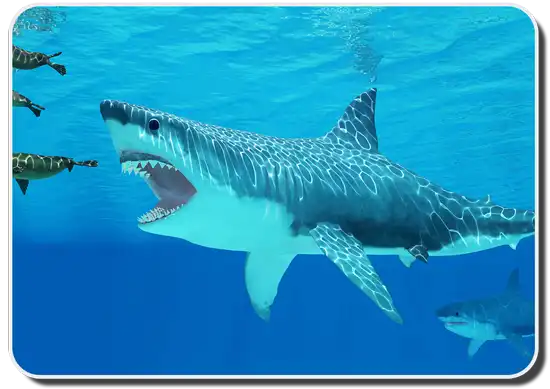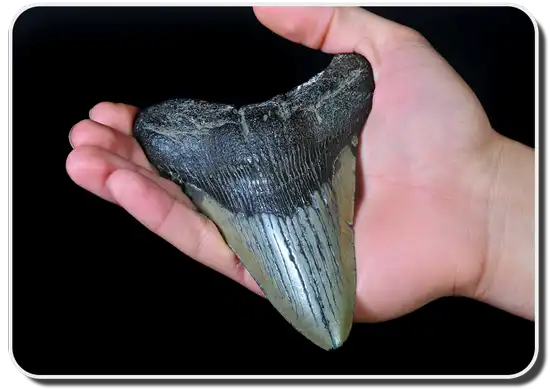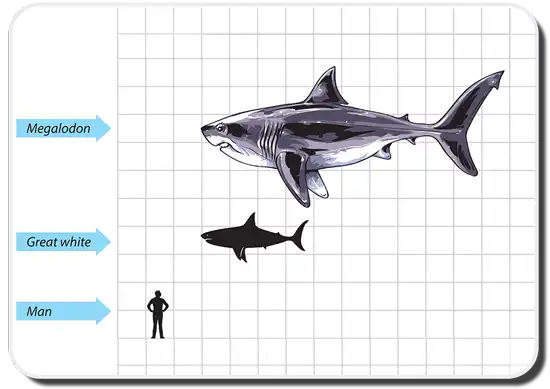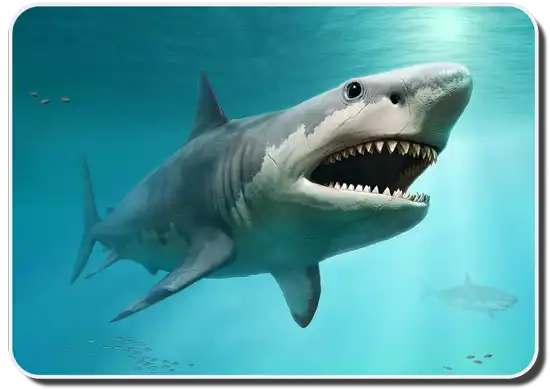
The Megalodon Shark (Carcharodon Megalodon) was a massive being that would put modern day sea predators to shame. If you are currently afraid of the Great White Shark, then I’m sure you’re happy that you don’t have to worry about the Megalodon creeping up under your sailboat. This colossal being was not one to mess with, and although the Megalodon is now extinct, its memory most definitely deserves to be respected and well known.
How scientists know about this giant prehistoric beast?
Just like the sharks of today, these sharks were comprised mainly of cartilage. So even though these sharks were immense, the majority of their bodies were not fossilized; cartilage usually disintegrates too fast for the fossilization process to occur. Therefore, there are still many factors of the Megalodon that we are unsure of. Luckily, some teeth have been found and investigated. Because of this, paleontologists have managed to uncover quite a few facts about these amazing creatures, and although many specifics are still being debated, there are a few things that most are definitely in agreement on.
Megalodon Teeth Are No Joke
Our first of the Megalodon shark facts deals with the “chompers,” so infamously associated with these sea creatures. The initial name for the Megalodon was Carcharodon Megalodon, which informally, was referred to as the “Megatooth,” shark. As you might’ve guessed, Megalodon teeth are no joke. In fact, they are the largest in size of any known shark species.
Megalodon teeth are also the most common fossil type found from the extinct species. This is because all sharks are primarily made of cartilage; making other Megalodon findings hard to preserve and difficult to conduct research with. Therefore, scientists rely heavily on Megalodon teeth in order to find more information of the giant sharks. Some of these teeth findings have measured up to 180 millimeters (7.1 inches) in diagonal length! They are usually triangular, incredibly thick, V-shaped, and carry many fine serrations.

Megalodon Diet
Another fact from our list of fascinating Megalodon shark facts deals with the creature’s diet. Evidence from Megalodon fossils show that the fish ate dolphins, whales of every size, sea turtles, porpoises, and pretty much anything else that inhabits the sea. Scientists have discovered whale bones that feature giant teeth marks and deep gashes; indicators that these marine mammals were main course meals for the Megalodon.
The Megalodon had no judgement when it came to choosing prey. In fact, they had a tendency to be cannabilistic, and would eat fellow sharks if times were desperate enough. No creature of the sea could avoid the appetite of the Megalodon.
Megalodon Hunting Behavior
To understand the hunting behaviors of Megalodon Sharks, scientists often look at Great White Sharks. Like Great White Sharks, Megalodon Sharks were built to be incredible hunters. They had strong, powerful jaws with an estimated bite force of 11-18 tons (9.9-16.3 tones). They have massive teeth that grew to 7 ¾ in (19.6 cm) in length in 46 rows. Their bodies were streamlined and powerful so they could swim incredibly fast. Scientists estimated with their massive size they could swim at 16.5 ft (5 m) per second, twice as fast as any shark on the planet today. They were also very adaptive hunters. Researchers have noted that based on fossil records of Megalodon’s prey, Megalodon used different attacks strategies for different kinds of prey. It is believed they were better hunters than their Great White Shark predecessors.
Megalodon Shark Habitat
Based on the locations of fossil records, scientists believe that Megalodon Sharks lived all over the world. They lived in temperate, tropical, and subtropical waters. Megalodon Shark fossil records have also been found in colder waters, so scientists believe they could regulate their body temperatures with mesothermy. Megalodon Shark fossils have been found along both the coasts in shallow and sandy waters and in the open oceans in deeper waters. Scientists believe that where Megalodon Sharks lived depended on their age. Younger Megalodons were spawned along the coastlines, and would stay and hunt marine mammals until they reached maturity. Once they were fully grown, they hunted in open waters for larger prey like whales.
The Oldest Megalodon Fossil
We know that the Megalodon roamed the prehistoric seas, but how long ago was that exactly? The last of our Megalodon shark facts deals with the earliest Megalodon remains found by scientists.
The earliest discovered Megalodon remains are reportedly from the late Oligocene, making them nearly 28 million years old! However, it has become a more generally accepted claim that the Megalodon ruled during the Middle Miocene, making it about 15.9 million years old instead. Fossil evidence has suggested that the Megalodon became extinct during the Pilocene, which was about 2.6 million years ago.
Widely accepted facts
From 70 million to 10 million years ago, the wonder known as the Megalodon Shark ruled the warm waters of Earth. Based on what researchers have discovered, the Megalodon had many physical and behavioral similarities to the Great White Shark; however, one of the main differences between the two was that the Megalodon was substantially more menacing and intimidating. The average great white can be anywhere from 15 to over 20 feet (4 to over 6 m) long. Yes these lengths are pretty impressive, but it does not even compare to the Megalodon Shark. The exact lengths of these ancient sharks are still in discussion, however, we do know that the Megalodon was approximately 40 to 70 feet (12 to 21m) long! They are also known as the “megatooth” shark and was the largest carnivorous fish that has ever existed on Mother Earth.

Scientists have studied Megalodon teeth that were found in Africa, North America, South America, India, Australia, Japan, and Europe. Based on the locations that these teeth were unearthed, it is the firm belief that they thrived in the world’s warmer waters. As mentioned earlier, scientists are still trying to uncover particulars of this prehistoric shark, including their diet. Since the great white shark is a descendant of the “megatooth” shark, most believe that the diet of the great white shark reflected that of the Megalodon. However, based on the serration marks found on the “mega” teeth of the ancient shark, it is believed that they also fed upon whales.
A possible reason for extinction
Yes, the Megalodon Shark is extinct. Unfortunately, due to the fact that not much information has been determined regarding these incredible beings, the absolute reason of why they all died off is unknown. There are a few theories that would explain the extinction of these animals, however. Two of the main speculations actually coincide with the belief that these sharks swam in warm waters. During the time when these sharks were still living, the temperature of the oceans began to decrease. The oceans’ steadily increasing colder temperatures may very well be what killed off the Megalodon Shark. Another plausible belief is that the ancient shark’s preferred prey began to migrate to colder waters. These low temperature waters were probably too cold for the Megalodon to survive.

Is the Megalodon Shark still alive?
Interestingly enough, there are many who refuse to believe that the Megalodon Shark is indeed extinct. Skeptics feel as if the Megalodon Shark may possibly be in existence deep down in the ocean. While it is true that we have not explored every inch of the world’s oceans, and it is likely that there are undiscovered species living in the depths of the waters, the belief that the Megalodon Shark may still be alive today has yet to be proven. Sharks are known for shedding hundreds of teeth on a regular basis; if the Megalodon Shark was still alive, they would be expected to shed the most teeth out of all of these sharks. Every Megalodon tooth that has been found is ancient. Until a fresh Megalodon tooth, a “megatooth” shark sighting, or some other form of proof has been presented, it is determined that this ancient shark is most definitely extinct.
Arguments Against The Existence Of Megalodon Sharks
Though cryptozoologists have a lot of anecdotal evidence that Megalodon Sharks still exist, scientists need hard evidence before they can really believe it is out there. In fact, most scientists look at the Megalodon Shark facts that we know and say there’s no way it could still be out there. Here are just some of the reasons scientists argue that Megalodon does not still exist:
- People Would Find Their Teeth: Though the argument that Megalodon could avoid detection, all sharks routinely lose their teeth. So if Megalodon Sharks were still out there and we couldn’t see them, we would still find their teeth. Especially since their teeth are so massive.
- Photographs Are Misleading: Basking Sharks are a large lamniformes shark that are often mistaken for Great Whites because they have a similar body. Basking Sharks often grow to 33 ft and could easily be mistaken for a Megalodon. So Megalodon photographs are most likely Basking Sharks.
- Newly Discovered Ocean Species Do Not Mean Megalodon Exists: Just because we have found species like Coelacanth and Megamouth does not mean that Megalodon is still in the ocean. Also the simple fact that we may not have seen the giant squids but knew the existed is further proof that these things are not evidence of Megalodon’s existence.
- People Would See Them: Megalodon was a warm water shark that hunted a lot like a Great White. If Megalodon was still hunting our oceans, we’d see them hunting alongside Great White Sharks. They also mainly ate whales, so we would see them attacking and hunting whales, or at least evidence of giant sharks eating whales.
So even though it is fun to think about Megalodon still swimming in the ocean, the arguments for its existence are pretty weak. Megalodon Shark facts are clear to scientists and they argue if they were still out there we would absolutely know. So for now, we’ll just keep the enduring existence of Megalodon in our imaginations.
